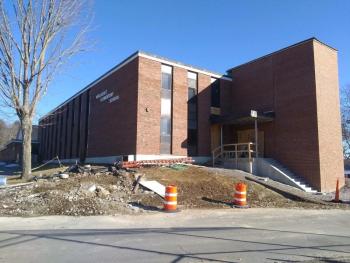WES elevator nears completion
Barring the unforeseen, the $1,025,000 elevator project at Wiscasset Elementary School will be completed this month, bringing the building back into compliance with the Americans with Disabilities Act.
“The good news is we’re still within our budget,” John Merry, school facilities director, told Wiscasset Newspaper Tuesday, Feb. 6. “The plan is to finish up during the school’s February vacation break and have it fully operational when staff and students return. We’re still waiting to have its telephone installed; that’s scheduled for next week, and after that it will have to be inspected and certified by the state’s elevator and tramway division.”
Because the school’s stairwell was too narrow to accommodate an elevator, a two-story brick addition was needed on the end of the building and required several months to construct. Blane Casey Contractors of Augusta began the site work for the elevator’s construction last June. Before work could start, a wooden staircase and walkway at the south entrance had to be cleared away and a tree taken down. Over the summer, temporary walls on all three floors were installed to separate students and staff from the work and create a buffer for the noise.
David Coons, Blane Casey’s construction superintendent, said the block and brick work was subcontracted to Giroux & Family Masonry Inc. of Lewiston. Esm Electrical Systems of Maine, based in Auburn, did the electrical work. Coons said landscaping of the grounds around the new addition will be carried out in the spring when work on the school’s south entrance is completed.
“We’re very pleased with the work,” Merry added. “As people can see the new brick addition really blends in nicely with the existing building.” Merry said the elevator’s installation isn’t the biggest school department project he’s been involved in since becoming facilities director in 1998. “The biggest one was the $1.5 million energy saving project that we carried out in 2018.”
For years, the K-5 grade school on Federal Street relied on an electric chairlift to carry students and staff unable to use the stairs from one floor to another. This half of the school, still known as the “new wing,” was built in the 1960s. The metal-framed chairlift, which was 35 to 40 years old, was no longer safe or reliable to use, having been out of service for a year. Merry said the school department had looked into replacing it but found the stairways weren’t wide enough to accommodate the type of lift needed.
“I think once they get used to it the staff, students and visitors will really appreciate having it,” he said of the elevator.


























